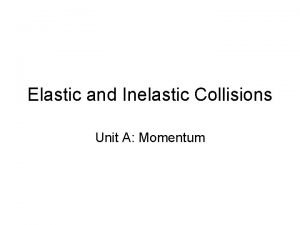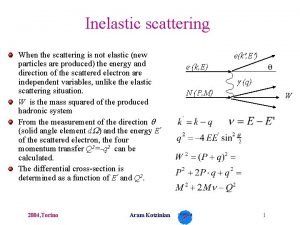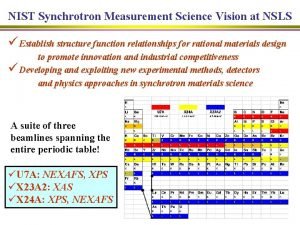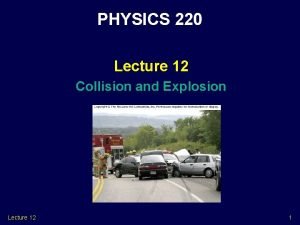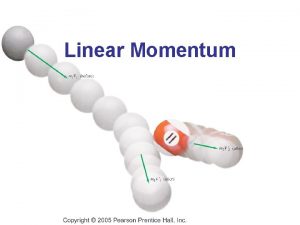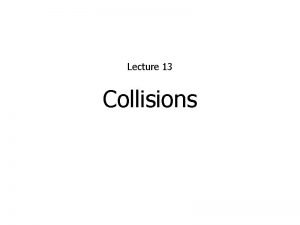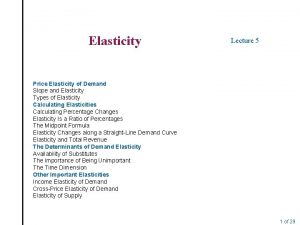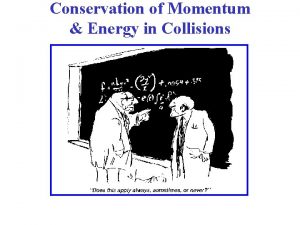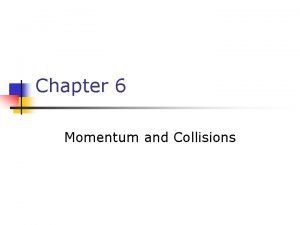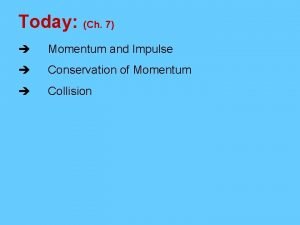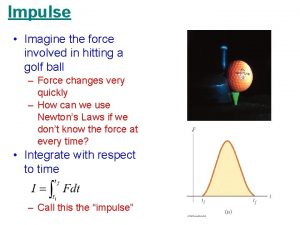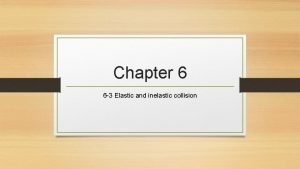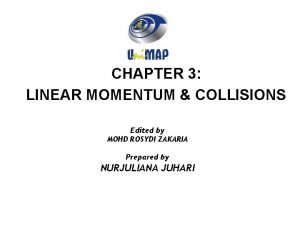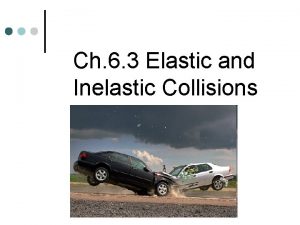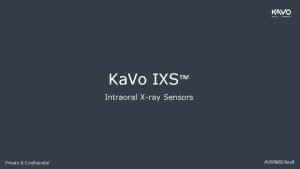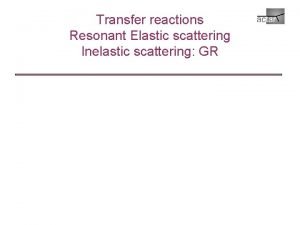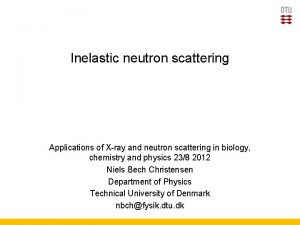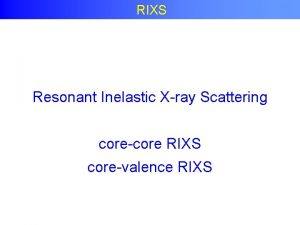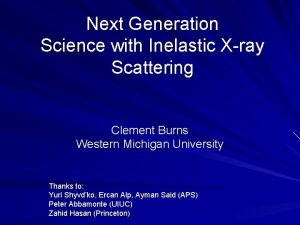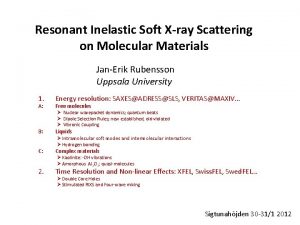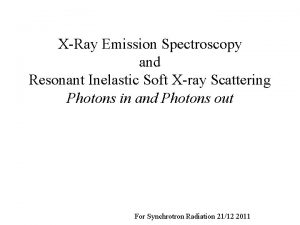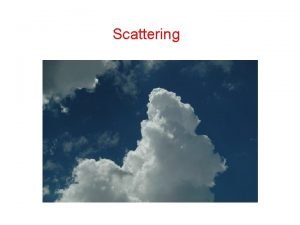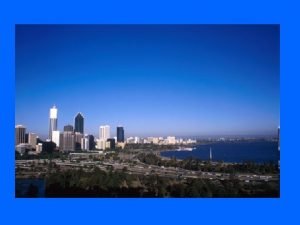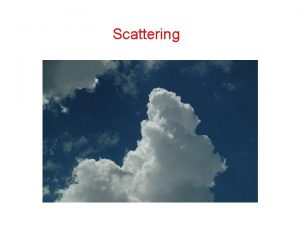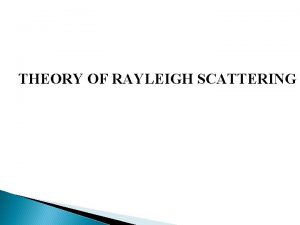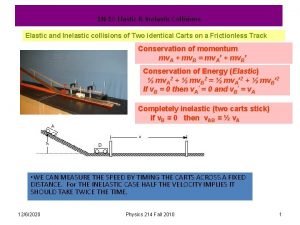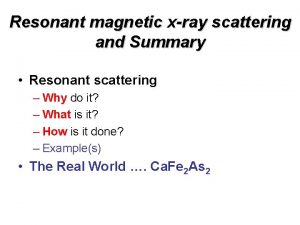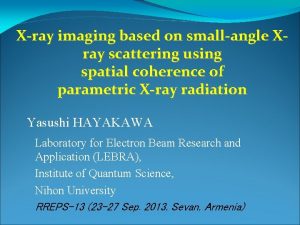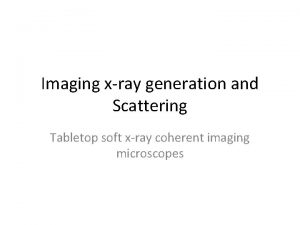Inelastic Xray Scattering at NSLS II IXS Program





















- Slides: 21

Inelastic X-ray Scattering at NSLS -II IXS Program, and Current Project Beamline Design Yong Cai With contributions by John Hill, Xianrong Huang, Zhong, Scott Coburn (NSLS-II) IXS@NSLS-II Workshop, February 7 -8, 2008 Alfred Baron (RIKEN), 1 Yuri Shvyd’ko (APS), BROOKHAVEN SCIENCE

IXS: Current Status • A powerful (but weak) probe offering energy and momentum • • resolved information on dynamics and excitations in condensed matter systems Practical applications with highly successful state-of-the-art implementation at ESRF, SPring-8 and APS Broad areas of applications, including but not limited to the followings: Lattice dynamics – Phonons in solids, vibration modes and relaxation processes in disordered systems: routinely operational at ~1 me. V resolution with ~109 photons/sec at ~20 ke. V using symmetric backscattering crystal optics Charge dynamics – Plasmon in simple metals, complex electronic excitations in strongly correlated systems: best resolution at ~50 me. V with ~1011 photons/sec at ~10 ke. V for the most demanding experiments Element specific applications – Chemistry and materials science, materials under extreme conditions of pressure and temperature: x-ray IXS@NSLS-II Workshop, February 7 -8, 2008 Raman scattering, x-ray emission and absorption spectroscopy by partial BROOKHAVEN SCIENCE 2

IXS Opportunities at NSLS-II • Key scientific drivers identified thru community inputs (CDR, user workshops) 0. 1 -me. V scientific case: filling the gap between high and low frequency probes • Visco-elastic crossover behaviors of disordered systems and fluids • New modes in complex fluids and confined systems • Collective modes in lipid membranes and other biomolecular systems 1 -me. V scientific case: • Relaxation processes in disordered systems (glasses, fluids, polymers …) • Phonons in single crystals, surfaces, thin films, high pressure systems, small samples • Exotic excitations in strongly correlated systems 10~50 -me. V (including lower resolution) scientific case: • Non-resonant and resonant inelastic scattering on charge dynamics • X-ray Raman scattering, x-ray emission and absorption spectroscopy by partial fluorescent yield combined with small beam for small samples of micrometer scale, high pressure, high fields, low and high IXS@NSLS-II Workshop, February 7 -8, 2008 temperature … BROOKHAVEN SCIENCE 3

Scientific Mission of the Project Beamline • • Develop advanced instrumentation that enables IXS experiments at extremely high resolution of 0. 1 me. V at ~10 ke. V – a key goal for NSLSII. Why 10 ke. V, as opposed to 20 ke. V or higher? Technical merits: higher brightness and flux for NSLS-II Scientific merits: better momentum resolution for a given solid angle, or the same momentum resolution for larger solid angle Counting efficiency: a complex issue, sample and optics dependent, require careful evaluation Possible scheme based on highly asymmetric backscattering optics proposed by Yuri Shvyd’ko working at 9. 1 ke. V, require considerable R&D (more from Xianrong Huang and Zhong’s talks) What are the alternatives? IXS@NSLS-II Workshop, February 7 -8, 2008 4 BROOKHAVEN SCIENCE

Specifications and Requirements • • Radiation source Provide flux > 1010 phs/s/0. 1 me. V at 9. 1 ke. V, to provide > 109 phs/s/0. 1 me. V at sample, require beamline overall efficiency > 10% Essential source size and divergence stability, vibration and thermal stability for achieving the 0. 1 me. V resolution (more from Xian. Rong Huang’s talk) Beamline and Endstations Two end stations, one with 0. 1 me. V and the other with 1 me. V resolution Primary beam energy at 9. 1 ke. V to match scheme for achieving 0. 1 me. V resolution Beam energy tunable over 7~12 ke. V for added flexibility (e. g. , other refractions) Energy scan range: order of 0. 1 ~ 1 e. V, appropriate for the excitations to be studied Momentum resolution: 0. 1 ~ 0. 4 nm-1 at 9. 1 ke. V Momentum range: up to 80 nm-1 to cover typical BZ sizes, ~120º at 9. 1 ke. V IXS@NSLS-II Workshop, February 7 -8, 2008 BROOKHAVEN SCIENCE 5 Spot size: ≤ 10 μm (H) x 5 μm (V), required for high pressure

Overall Beamline Layout R-wall: 28. 3 m Walkway: 60. 8 m Beamline o K B ccupies a h HRM 1. 0 me. V Endstation* KB HRM VFM VC DCM M 0. 1 me. V Endstation - CDDW HRM (0. 7 me. V) - CDDW HRM (0. 1 me. V) - CDW Analyzers (0. 7 me. V) - CDW Analyzers (0. 1 me. V) - larger q range (~80 nm-1) - 0. 1 nm-1 q resolution * (not in the project scope) igh-β strai ght sectio - limited q range FOE - HHL DCM - VFM / VCM IXS@NSLS-II Workshop, February 7 -8, 2008 6 BROOKHAVEN SCIENCE

Optical Scheme for 0. 1 me. V • • CDDW mono to achieve 0. 1 me. V with ~100µrad angular acceptance Multilayer mirror to achieve 5~10 mrad angular acceptance for CDW/CDDW a Δθe = ~ 5μrad E = 9. 1 ke. V for Si(800) Side view ΔE = 0. 1 me. V, φ = Si(800) 89. 6° Si(111) Si(220) ~20μrad divergence < 5: 1 ~100μrad focusin g Si(800) acceptance IXS@NSLS-II Workshop, February 7 -8, 2008 7 BROOKHAVEN SCIENCE

Multilayer Mirror for Analyzer • Requirements: 100: 1 demagnification (from 10 mrad to 0. 1 mrad) 10 mrad angular acceptance Greater than 50% efficiency Possibility for parallelization of data collection E = 9. 1 ke. V m 0 c ~1 CDDW analyzer with ~0. 1 mrad acceptance We hope the beam here is a slightly focused beam with divergence ~0. 1 mrad and beam height ~50 µm We hope the mirror length to be ~10 cm. It can be either a (1) laterally graded multilayer or (2) a parabolically / elliptically bent periodic multilayer IXS@NSLS-II Workshop, February 7 -8, 2008 8 BROOKHAVEN SCIENCE

Conceptual Beamline Layout • Multilayer mirror with 100: 1 demagnification to provide 10 mrad (vertical) angular acceptance for analyzer ~10 m arm length IXS@NSLS-II Workshop, February 7 -8, 2008 9 BROOKHAVEN SCIENCE

Experimental Floor Layout 25 m BM line • • ~53 m Space may be sufficient for only one end station based on current scheme and 10 mrad angular acceptance for analyzer ID line Another ~8 m may be required for a second end station with 5 mrad angular acceptance for analyzer, space for mirrors and phase plates ~61 m + 2 m (possibly) IXS@NSLS-II Workshop, February 7 -8, 2008 10 BROOKHAVEN SCIENCE

Insertion Device • U 20 (IVU), or U 14 (SCU) on a high-β straight section Figure of Merit: Flux / me. V – provide flux > 1010 phs/s/0. 1 me. V at 9. 1 ke. V Name U 20 U 14 Type IVU SCU Period (mm) 20 14 L (m) 3. 0 2. 0 No. Periods 150 143 Bmax (T) 0. 97 1. 68 Kmax 1. 81 2. 20 Tot. Power (k. W) 8. 024 16. 0 8 On-axis 62. 65 103. * U 20: baseline device PD 7 IXS@NSLS-II Workshop, February 7 -8, 2008(k. W/mrad 2) BROOKHAVEN SCIENCE 11

Insertion Device Optimization • Optimize to maximize flux at 9. 1 ke. V: magnet period vs length vs minimum gap Until superconducting devices become an option, the U 20 -5 m seems to be the Basic Undulator Parameters #1 #2 #3 #4 #5 Baseline Proposed best option Name Type Period (mm) Length (m) No. of Periods Minimum gap (mm) Bpeak (T) Keff Minimum 5 th harmonic energy, linear mode (e. V) Total power (k. W) Power density (k. W/mrad 2) U 20 -3 m PMU U 22 -6 m PMU 20 3 150 5 0. 969 1. 81 22 6 272 7. 5 0. 725 1. 4893 8099. 45 8. 024 62. 65 9210. 20 8. 955 84. 32 U 21 -4. 5 m U 20 -4. 5 m PMU 21 20 4. 5 214 225 7. 5 7 0. 85 0. 88 1. 66671 1. 64336 8518. 10 9. 244 78. 15 9091. 00 9. 922 85. 02 U 20 -5 m PMU 20 5 250 7 0. 88 1. 64336 9091. 00 11. 02 94. 47 Performance at 9. 1 ke. V, 5 th harmonic (for 9. 3 m high-β straight, beta_x=20. 8, beta_y=2. 94) Brightness (phs/sec/mrad 2/mm 2/0. 1%BW) Total Flux (phs/sec/0. 1%BW) Brightness ratio with baseline: Flux ratio with baseline: 4. 68 E+20 4. 60 E+20 4. 25 E+20 8. 00 E+14 1. 06 E+15 1. 01 E+15 IXS@NSLS-II Workshop, February 7 -8, 2008 1. 00 0. 98 0. 91 1. 00 1. 33 1. 26 12 4. 90 E+20 5. 42 E+20 1. 20 E+15 1. 35 E+15 1. 05 1. 16 1. 50 1. 69 BROOKHAVEN SCIENCE

Extended Long Straight • • • It is possible to obtained one 15 m extended long straight by extending one 9. 3 m high-β straight and shortening two adjacent 6. 6 m low-β straights of the current lattice Preliminary solution indicates that it would be possible to put in two U 20 -5 m devices with refocusing magnet. Potentially more than triple (3. 38 times) the flux compared to one U 20 -3 m baseline device There accelerator issues (tune shift compensation, radiation shielding) and cost impact. βx = 18. 5, βy = 3. 5 for extended LS βx = 0. 8, βy = 0. 8 for short straights IXS@NSLS-II Workshop, February 7 -8, 2008 13 BROOKHAVEN SCIENCE

Straight Section • • High-β straight section (9. 3 m) is required for a long device Additional benefits associated with a high-β compared to a low-β straight section : • Bigger horizontal source size but smaller horizontal divergence, leading to smaller horizontal photon beam size shorter horizontal mirrors • Lower power load within the central cone of the photon beam delivered to the first optics heatload is more manageable for first optics, even for two U 19 undulators. • Important: Flux within the central cone remains the same! Distanc K Low-β High-β Photon beam size and power (one U 19, at 9. 1 ke. V) thru angular aperture e, m of 4 s(H)x 4 s(V). Aperture Beam Size 2 Power, (Hx. V), μrad 2 30 1. 71 3 30 0. 98 1 (Hx. V), mm 79. 2 x 22. 8 2. 4 x 0. 7 W 118 65 (Hx. V), μrad 2 29. 2 x 20. 0 (Hx. V), mm 1. 0 x 0. 6 W 38 21 IXS@NSLS-II Workshop, February 7 -8, 2008 14 BROOKHAVEN SCIENCE

First Optics Enclosure (FOE) C sc ool r e W een d f lu hi. te b ea Bl m ad s e BP lit B M co rem llim ss at tra or hl un D ia g m C o m ool nd as ed w k fi ind xe o d w PM W B hi st rem te b op s e st am ra hl & un D g C M B an t ua dr Q • DCM: cryogenic cooled Si(111). FEA analysis on first crystal of DCM shows < ± 5 µrad slope error at 115 W heat load For high-β straights, thermal effect would be less a problem (lower heat load). VF M • • IXS@NSLS-II Workshop, February 7 -8, 2008 15 BROOKHAVEN SCIENCE

Beamline Collimating and Focusing Optics • Candidate: Bimorph mirrors • Supplied by SESO • Multiples of 150 mm in length • Each segment can be bent independently (2 electrodes for cylindrical and 4 electrodes for elliptical) • Bimorph can in principle correct its own tangential polishing slope errors and also correct for tangential errors introduced by other optics • KB bimorph pair can in principle correct for sagittal and tangential errors • Small beam size allows short mirrors with small incident angle BROOKHAVEN SCIENCE 16 (2. 5 mrad) and Si substrate for IXS@NSLS-II Workshop, February 7 -8, 2008

Shadow Ray Tracing with FEA Results Case Model , LN 2 cooled DCM (εx = 0. 55 nm-rad) Spot size , μm (No distortion) Flux, ph/sec (No distortion) Spot size, μm (W/ distortion) Flux, ph/s/e. V (W/ distortion) 1 Lo-β, K=0. 981, 1 U 19 -3 m, 22 W 2. 0 x 1. 8 1. 50 x 1013 2. 1 x 2. 1 1. 49 x 1013 2 Hi-β, K=0. 981, 1 U 19 -3 m, 7 W 7. 0 x 1. 8 1. 49 x 1013 7. 0 x 2. 0 1. 49 x 1013 2 a Same as 2, but water cooled 7. 0 x 1. 8 1. 49 x 1013 16 x 7. 4 1. 51 x 1013 3 Lo-β, K=1. 714, 1 U 19 -3 m, 71 W 2. 0 x 1. 9 2. 88 x 1013 2. 3 x 4. 2 2. 81 x 1013 3 a Same as 3, but hot spot at 2. 0 x 1. 9 2. 88 x 1013 2. 1 x 0. 5 125 K IXS@NSLS-II Workshop, February 7 -8, 2008 2. 92 x 1013 3 b Same as 3, but 2 U 19 -3 m, 2. 0 x 2. 017 5. 80 x 1013 2. 9 x 5. 9 BROOKHAVEN SCIENCE 5. 14 x 1013

0. 1 me. V Endstation Layout Features • Pre-focusing (up to 5: 1) to reduce Instrument NSLS-II, 3 m U 19 length of collimator (C) crystal for 0. 1 me. V HRM • KB mirrors after HRM for micro focusing to ≤ 10(H) x 5(V) μm 2 • Temperature scan of energy transfer • Analyzer(s) based on the CDW or CDDW scheme with multi-layer focusing mirror(s) to achieve 10(H)x 5(V) mrad 2 angular acceptance • High (0. 1 nm-1) momentum resolution in forward scattering, limited scan range Intensity at Sample Extremely clean energy resolution > 1 x 109 • ph/sec/0. 1 me. V (estimate)function APS, 5 m U 30 1 x 109 ph/sec/1 me. V SPring-8, 4. 5 m U 32 5 x 109 ph/sec/1 me. V IXS@NSLS-II Workshop, February 7 -8, 2008 18 BROOKHAVEN SCIENCE

1 me. V Endstation Layout Features • Pre-focusing (up to 2: 1) to reduce length of collimator (C) crystal for 0. 7 me. V HRM • KB mirrors after HRM for micro focusing to ≤ 10(H) x 5(V) μm 2 • Temperature scan of energy transfer • Analyzer(s) based on the CDW or CDDW scheme with multi-layer collimating mirror to achieve 10(H)x 5(V) mrad 2 angular acceptance A natural step in achieving 0. 1 me. V resolution • Large momentum scan range (up to 80 nm-1 at ) for single crystal studies, Instrument Intensity Sample require phase plates NSLS-II, 3 m U 19 > 1 x 1010 ph/sec/1 me. V • Extremely clean energy resolution (estimate) function 9 APS, 5 m U 30 1 x 10 ph/sec/1 me. V SPring-8, 4. 5 m U 32 5 x 109 ph/sec/1 me. V IXS@NSLS-II Workshop, February 7 -8, 2008 19 BROOKHAVEN SCIENCE

Schedule Summary • 2008~2011: Design phase, interaction with BAT, actively pursue 0. 1 me. V R&D • 2011~2013: Construction phase, long lead-time procurements to begin in final • 2014: Integrated testing phase, to be ready to take beam IXS@NSLS-II Workshop, February 7 -8, 2008 20 BROOKHAVEN SCIENCE

Outstanding Issues • • • Multiple undulators on extended straight for more flux (depends on AS design) tuning compensation for beam dynamics, heat load on second undulator, cost impact CDDW scheme to achieve 0. 1 me. V HRM: Substantial R&D effort required (proof of scheme by end 2010, final design phase) Multilayer mirror to achieve 10 mrad angular acceptance for CDW / CDDW analyzers: (proof of scheme by early 2010, preliminary design phase) Risks with current approach and mitigation strategies: 1 me. V is promising, 0. 1 me. V remains a major challenge, aggressively pursue the R&D and seek alternatives Possibility to combine two end stations into one: energy resolution tuning Parallel data collection: multiple analyzers, area detector IXS@NSLS-II Workshop, February 7 -8, 2008 21 Your inputs are important! BROOKHAVEN SCIENCE
 Elastic vs inelastic vs perfectly inelastic
Elastic vs inelastic vs perfectly inelastic Elastic vs inelastic collision
Elastic vs inelastic collision Elastic scattering vs inelastic
Elastic scattering vs inelastic Nsls foundation
Nsls foundation Inelastic collision
Inelastic collision Linear momentum and collisions
Linear momentum and collisions Inelastic collision examples
Inelastic collision examples Loss of kinetic energy in inelastic collision
Loss of kinetic energy in inelastic collision Elasticity measures
Elasticity measures Perfectly elastic demand curve is
Perfectly elastic demand curve is Unitary elastic.
Unitary elastic. Perfectly inelastic demand
Perfectly inelastic demand Consumer surplus and producer surplus
Consumer surplus and producer surplus Momentum with friction equation
Momentum with friction equation Momentum between two objects
Momentum between two objects Glancing collision
Glancing collision Consumer surplus inelastic demand
Consumer surplus inelastic demand Example of inelastic collision
Example of inelastic collision Inelastic collision examples
Inelastic collision examples Types of collision
Types of collision Perfectly inelastic collision definition
Perfectly inelastic collision definition Elastic potential energy real world examples
Elastic potential energy real world examples
